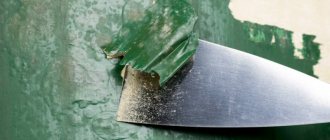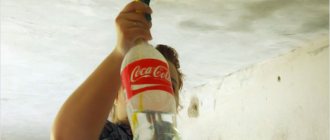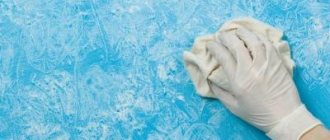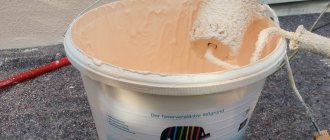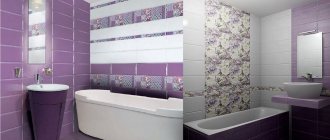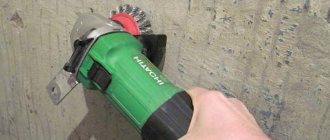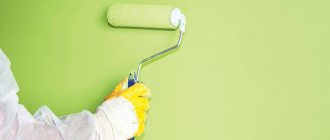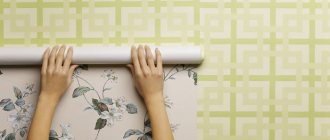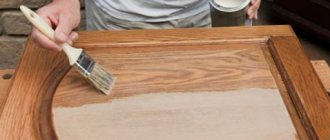Repainting walls is sometimes very difficult if there is old enamel on them. Often owners want to decorate the interior differently or simply update the design. If you have already purchased tools and selected good paint for exterior work, you can safely begin the repair. You just need to remove the base coat that has become unusable.
There are several ways you can remove old water-based paint. They are all quite simple, you just need to follow simple rules. Let's talk in more detail about such methods and note their features. After reviewing our material, you can choose the most convenient and practical option for yourself.
Use of solvent and its derivatives
Like all paints, water-based paint can be easily removed with a solvent. Such compositions are often used to treat walls before painting. Even if the old film is quite thick, it can be quickly removed with the following substances:
- isopropyl alcohol;
- solvent;
- formic alcohol;
- white spirit.
Such compounds are quite toxic, so it is advisable to work with them in personal protective equipment. Use respirators and special glasses to protect your eyes and respiratory organs.
Preparing for work
The most popular paint in any hardware store is water-based paint, so everyone should know how to remove water-based paint from walls or ceilings. It has many advantages, including:
- Possibility of application to any surface;
- wide selection of shades;
- no repulsive aroma;
- can be easily washed off from dirt;
- no further maintenance required.
Despite all the positive aspects, there is also a significant disadvantage - the difficulty in removing spilled paint.
Before you begin removing paint, you should understand what type of coating was treated with dye - this is what affects the method that will help you get rid of the paint. In addition, it is necessary to carefully prepare all the tools that may be needed for this procedure.
The floor covering must be covered with plastic film or newspaper so that debris from the walls does not damage the linoleum (parquet). Then you need to prepare a basin or bucket into which you need to pour water; find a rag.
You also cannot do without spatulas to scrape off any remaining dye. It is recommended to prepare a roller so that you can use it to wet the ceiling or walls. In order for water to get into the middle of the paint, you should prepare a brush that will be equipped with metal bristles - it will scratch the coating during application. You will also need sandpaper.
For maximum effectiveness, you can use solvent or acetone.
Paint removers
They sell ready-made paint remover solutions in spray cans - they are quite effective and easy to use. They are applied to a dry, clean surface and removed after a few minutes. They quickly dissolve the old coating; it can be easily removed with a rag. Detailed instructions are indicated on the packaging. These compositions are very dangerous for mucous membranes; you must also work with them using personal protective equipment. In case of contact with the eyes, nose or mouth, the substance should be washed off the surface with a large volume of clean running water.
Advice from professionals
The soap solution is suitable for water-based paint with a non-waterproof composition. It's easy to check - wet a small area and wipe with a sponge. If stains appear on the wall and the dye remains on the sponge, it means that the material does not require special solvents.
Working with bar soap will be simplified if you first grate it , chop it finely, and scrape it with a knife.
Additionally, you can apply small notches to the wall (for example, with a knife or the corner of a spatula) - the softening process will go faster. The main thing is not to make the scratches too deep, so as not to damage the base of the wall.
When working with a hair dryer or other power tools, craftsmen recommend dividing the wall into sections and marking the boundaries (with a pencil or other convenient method). This approach will allow you to move in the right direction and track the cleaning stages and operating time.
If the heated composition gets from the wall to other places, it is better to immediately wipe it with a damp cloth . Otherwise, the paint will dry out again and you will have to re-treat it with a hairdryer or solvent. Professionals recommend covering all surfaces in the rooms - with newspaper, film, rags.
Do I need to wash it off?
If the water-based emulsion holds tightly and there are no areas with paint peeling, you can leave it. A new layer is applied to the old paint. If there are bubbles or areas of peeling paint on the surface, then the old layer of water-based emulsion must be removed.
Removal will be required during major repairs or if the surface is finished with another material incompatible with water-based paint. Removal is also required if the color changes from dark to lighter. The dark color will show through the light color, regardless of the number of layers applied.
You can delete it in several ways:
- wash off;
- remove thermally (annealing);
- mechanical method.
Possible options for the procedure
How to remove old finishes depends on the type of paint that was previously applied and the type of material used to construct the walls or ceiling.
Mechanical method
This method is best used when the walls are made of concrete or are being prepared for applying putty or plaster, gluing tiles or artificial stone. Any careless movement of the craftsman’s hands can lead to scratches or gouges, so before painting the damaged area will have to be puttied and sanded.
The basic principle of mechanical cleaning is to pre-wet the walls with water and then remove the paint using a spatula, scraper or wire brush.
To make the old finish come off more easily from the base, after wetting the moistened area should be left for 15 minutes, and then you can take a spatula. Removing paint in this way does not require special skills or knowledge, but it will take a lot of time and effort to completely clean the entire room.
Using soap solution
If in previous repairs the water-based paint was not washed off, but was applied in several layers, a soap solution will help remove the old finish.
Any detergent without aggressive chemicals, dyes and fragrances is suitable for its preparation:
- liquid soap;
- dishwashing gel;
- shampoo;
- washing powder.
Any of the listed products must be added to a basin or bucket of warm water and stirred so that a foam cap appears on the surface of the liquid.
The technology for using a soap solution is as follows:
- Using a knife or sharp spatula, small notches, cuts or punctures are made across the entire surface.
- A paint roller or paint roller is dipped in soapy water and wetted onto the wall or ceiling.
- After 10-15 minutes, when the treated area is well wet, remove pieces of paint with a scraper or metal spatula.
After the old finish has been removed, the cleaned base should be rinsed with clean water to prevent detergent residue from impairing the quality of future painting.
To remove old water-based emulsion, there are special products that dissolve in water before application.
Rinse with warm water
To remove a non-waterproof compound, you do not need to put in much effort or use complicated methods. It is enough to wet the wall with warm water, wait for the paint to soak and wipe it off with a rag, sponge or brush.
To wet the walls, it is better to take a paint roller with a fluffy nozzle: you need to dip it in a container of warm water and then roll it over the wall. The work will go even faster if you use a spray gun or a vacuum cleaner with a blowing function.
You should not wet all the walls at once, as water-based paint tends to dry quickly. The entire surface should be visually divided into zones and processed one by one. As soon as the area moistened with water darkens, you can begin to wash off the coating: dip a sponge or rag into a container of water, and then wipe the surface with light pressure.
The water in the basin will have to be changed periodically, otherwise the coloring pigment will be constantly transferred to the wall, and this will slow down the preparation for painting. In corners, joints and difficult areas where the paint is difficult to wash off, you need to use a metal spatula.
Using this method, you can remove old finishes from walls or wash dried paint stains from a stretch ceiling. When processing fabric or vinyl film, do not use sharp objects, as they can damage the integrity of the structure.
Isopropyl alcohol and mineral spirits for removing old water-based paint.
Solvent cleaning
It is better to treat persistent coatings with a solvent that can quickly dissolve the top layer of finish and make it easier to remove.
Builders advise using concentrated preparations:
- formic acid;
- isopropyl alcohol;
- White Spirit;
- solvents.
These reagents can be used to treat drywall, plaster, wood and other surfaces that cannot be subjected to mechanical stress. The use of chemicals is practically no different from the previous method, only in this version a solvent is used instead of water.
The main disadvantage of this technology is the high toxicity of the chemicals. Therefore, work should be carried out in a well-ventilated area and personal protective equipment should not be neglected. The safety and effectiveness of the reagent must first be tested on a small area of the wall.
Using special means
Aerosol remover for removing old paint.
Not every solvent can cope with old paint. In difficult cases, when other methods are ineffective, it is easier to buy a special remover or destroyer, which are available in the form of concentrated liquids or gels.
Modern means for removing old paint are universal and can be used on surfaces made of any materials - wood, concrete, metal, etc.
In addition, destroyers corrode old paint within a few minutes after application to the wall, making the work of preparing the room for painting much faster and easier.
Among the disadvantages of this method, users note the high cost of special tools and the need to comply with safety measures.
When can you leave water emulsion on the walls?
It is not always necessary to wash off the previous coating before applying a new one. An exception is made for a painted base in ideal condition, that is, there are no cracks, chips, bald spots on the wall, mold, mildew, or fallen areas.
The substance, firmly dried over the entire area, can perfectly withstand additional load without compromising quality. The one-piece coating will perfectly accept a new layer of paint. The primed surface will provide sufficient adhesion to other finishing material, as long as it does not weigh too much for acrylic.
New paint
Water-based paints are quite easy to remove, so almost anyone can do this type of work. Independent dismantling will not only save the construction budget, but will also instill confidence in the soul: you can try your best for yourself, which means you definitely won’t have to redo it. And if you have any doubts, you can always seek advice from an experienced specialist.
An example of proper self-removal of acrylic is shown in the following video:
Thermal method
You will need:
- ladder;
- construction hair dryer;
- scraper or spatula;
- sandpaper;
- sponge;
- water.
In this case, small areas of the old paint layer are heated with a hair dryer. When exposed to heat, the paint peels off and can be easily removed with a scraper or spatula. The remaining areas are cleaned with a brush and sandpaper, and after that the ceiling is washed well with a damp sponge.
We recommend
DOCKER S5 is an industrial remover of chemically resistant, complex paintwork with fast action (3-10 min.) Effectively removes multi-layer coatings, NC, CV paints, primers, enamels, putties, thermal paints. Can be used for interior and home work. Gel solution. Without smell. More details
How to remove acrylic paint
Wall paint removers
Removing water-based paint
Removing stains
Typically the most contaminated area is the ceiling and walls in the kitchen. However, even difficult stains can usually be removed. To do this, you should use several techniques. This will make the ceiling clean again. To get rid of stains, you should take baking soda and warm water. To prepare the solution, it is recommended to mix 5 large spoons of soda and 5 liters of water
Carefully treat the ceiling with the resulting mixture. It is permissible to apply the substance exclusively to the most contaminated fragments or to cover the entire surface
It is recommended to leave the composition on the ceiling for a maximum of a quarter of an hour.
Then carefully wipe the surface with a soft sponge and remove the soda solution. Pollution comes away with it.
If necessary, it is recommended to repeat the procedure. However, it is not necessary to wet the ceiling too much. This will cause the dye to peel off.
Recommendations
It is better to adhere to several main recommendations:
- To effectively remove paint from a wall or ceiling, it is necessary to apply water to a small area, otherwise the surface will dry out quickly, which will lead to the mandatory repetition of the procedure;
- If paint gets on furniture, remove it quickly, without waiting for it to dry completely;
- If paint gets on clothing, it must be washed with water or blotted with a napkin.
If you follow all the above tips, washing off water-based paint will be quick and easy.
